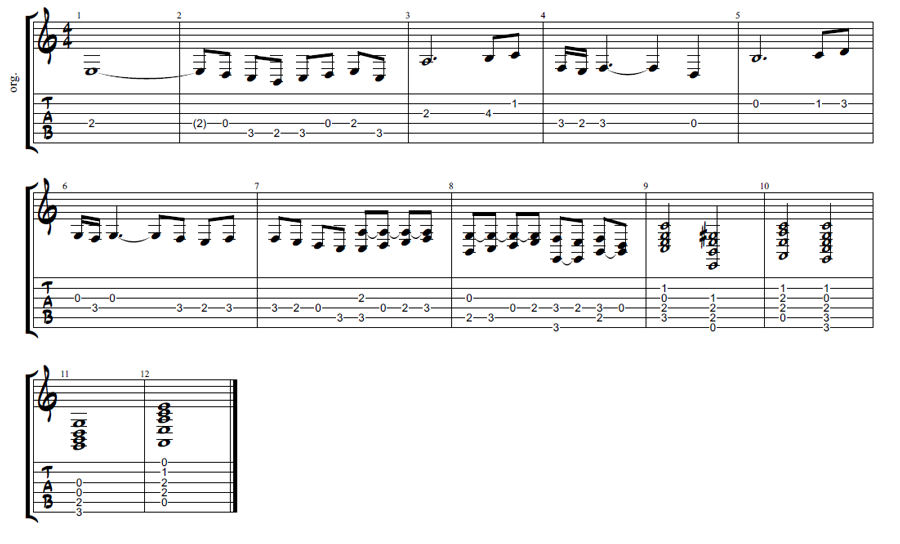The Timeless Influence of Classical Music on Rock
Procol Harum And The Iconic "A Whiter Shade of Pale"
In the ever-evolving world of music, there are few bands that so seamlessly blend the seemingly disparate worlds of classical composition and modern rock as Procol Harum.
One of the most iconic examples of this fusion is their hit "A Whiter Shade of Pale", whose haunting melody and evocative lyrics have stood the test of time.
Have a look at the following tab:

What some might not immediately realize is that the opening theme of this track is heavily influenced by the works of Johann Sebastian Bach specifically, a movement from his Suite No. 3 in D Major, commonly known as Air on a G String.
Classical Roots in Rock
The influence of Bach on "A Whiter Shade of Pale" is a testament to how classical music has permeated the world of contemporary rock.
The arrangement, led by Gary Brooker’s intricate piano work, captures the baroque essence of Bach while grounding it firmly in a modern context.
Keith Reid’s poetic lyrics intertwine with these classical elements to produce a sound that feels both familiar and groundbreaking.
The use of classical structures in rock music wasn’t entirely new at the time, but Procol Harum’s approach was unique.
Instead of merely borrowing a melody, they transformed it into a progressive rock anthem, paving the way for future bands to explore similar fusions.
The band’s decision to base their piece on such a well-known classical movement provided a familiar anchor while allowing them to venture into uncharted sonic territory.
The Role of Blues in Shaping Rock
The musical journey doesn’t end with classical influences.
Blues, a cornerstone of rock music, played a pivotal role in shaping the sound of many British rock bands in the 1960s.
Take, for example, John Mayall and his Bluesbreakers, who had a considerable influence on the rock scene by collaborating with musicians like Eric Clapton and Paul Butterfield.
This intersection of blues and classical elements created a rich, layered sound that resonated with audiences across the globe.
While Procol Harum’s classical leanings set them apart, the incorporation of blues elements by their contemporaries helped define the broader landscape of 1960s rock.
Bands like the Bluesbreakers, featuring raw blues-driven guitar lines, found ways to innovate by keeping the authenticity of the blues at their core, even while exploring more complex arrangements.
Harmonica and Guitar Techniques: Bridging Traditions
Another fascinating aspect of the musical landscape during this era is the use of unconventional instruments in rock.
The harmonica, typically associated with folk and blues, made a significant mark on rock during this time.
Instruments like the Hohner harmonica were staples in blues and rock alike, offering expressive nuances that guitar or piano couldn’t always deliver.
As highlighted in the article, there are various techniques involved in mastering the harmonica, from breath control to using the palm for subtle adjustments in tone and dynamics.
Guitarists, too, were adopting a similar experimental approach during this time.
The fuzz boxes and effects employed by guitarists like Syd Barrett of Pink Floyd pushed the boundaries of guitar tone, offering new ways to manipulate sound and emotion through gear.
The Enduring Legacy of Genre Crossovers
Ultimately, what "A Whiter Shade of Pale" and the bands of this era illustrate is how the lines between genres were continuously blurred to create something entirely new.
Rock musicians drew from jazz, blues, folk, and classical music, adding layers of complexity and emotion to their work.
For guitarists, this was an especially transformative period.
The instrument was no longer limited to traditional playing techniques artists could now experiment with effects, classical influences, and various genres to expand their musical vocabulary.
Procol Harum’s willingness to bring classical music into the realm of rock, combined with their peers’ embrace of blues and experimental sounds, opened the door to new possibilities in music.
It’s a legacy that lives on in the countless musicians who continue to innovate, blending the old with the new, and finding inspiration in unexpected places.
Whether you’re exploring new techniques on the fretboard or diving into the music theory behind your favorite tracks, there’s always something to learn from this golden era of music. And like Procol Harum, sometimes the key to unlocking something truly special lies in revisiting the past to create the future.
That's all! To stay updated, join us here